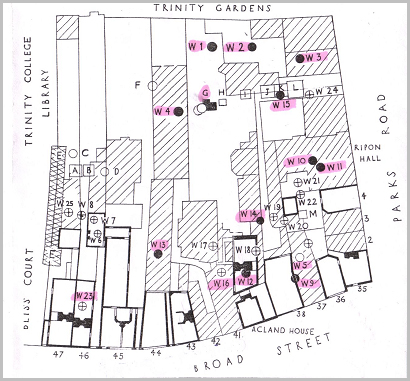|
The earliest
documents show that in 1210 AD there was a house on the site of No.42-4
Broad Street and one on an adjoining tenement ( see below General Site Plan Fig.4 ). Nos. 41-44 Broad Street were originally one tenement,
known as ‘Well Hall' and the Oxford Cartulary of Osney Abbey shows it was given to the
Abbey c.1220 AD. Quite what Well Hall was is uncertain. It
seemingly was never an academic hall. We know only that by the 17th and 18th
centuries it was tenanted by trades people (Pantin 1937, 188).
By 1262 AD
Deep Hall was recorded on the site of Nos.45 & 45A.
Documentary references start with its acquisition by Ralph Plumbarius
in 1230 AD. About 1261-2AD Petronilla de Wythulle gave the tenement
to the Hospital of St John the Baptist who then passed it on to Magdalen
College in the 15th century AD. Deep Hall was referred
to as an academic hall or approved lodging house for students in 1293
AD (Bruce-Mitford 1937,91) but was no longer one by 1385, and had not
been for some years previously (Pantin 1937, 188).
The unpublished
survey of Oxford in the Hundred Rolls of 1279 shows that by the last quarter
of the 13th century the whole site was inhabited and this occupation,
in at least two tenements, had originated at the beginning of the century.
By the late 16th century, documents show the occupants to be
primarily trades people engaged in occupations such as cook, tailor, bookbinder,
barber, apothecary and doctor. Documentary evidence
can be misleading in that it indicates ownership and not necessarily the occupier.
It was usual for 'noxious' trades to be placed outside the town walls,
although none of these trades seem particularly unpleasant, unlike the
tanning or black-smithing trade. The pottery assemblages from
the wells are much earlier, falling substantially in the 13th-14th
centuries and might give some clue to the social aspirations of those
actually living here in that time.

Figure
4: General Plan of the site showing the position of the Wells. Those wells
used in this reassessment are highlighted (from Bruce-Mitford 1939, Fig.20,
90)
|

